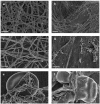Oxidation inhibits iron-induced blood coagulation
- PMID: 23170793
- PMCID: PMC3580830
- DOI: 10.2174/1389450111314010003
Oxidation inhibits iron-induced blood coagulation
Abstract
Blood coagulation under physiological conditions is activated by thrombin, which converts soluble plasma fibrinogen (FBG) into an insoluble clot. The structure of the enzymatically-generated clot is very characteristic being composed of thick fibrin fibers susceptible to the fibrinolytic degradation. However, in chronic degenerative diseases, such as atherosclerosis, diabetes mellitus, cancer, and neurological disorders, fibrin clots are very different forming dense matted deposits (DMD) that are not effectively removed and thus create a condition known as thrombosis. We have recently shown that trivalent iron (ferric ions) generates hydroxyl radicals, which subsequently convert FBG into abnormal fibrin clots in the form of DMDs. A characteristic feature of DMDs is their remarkable and permanent resistance to the enzymatic degradation. Therefore, in order to prevent thrombotic incidences in the degenerative diseases it is essential to inhibit the iron-induced generation of hydroxyl radicals. This can be achieved by the pretreatment with a direct free radical scavenger (e.g. salicylate), and as shown in this paper by the treatment with oxidizing agents such as hydrogen peroxide, methylene blue, and sodium selenite. Although the actual mechanism of this phenomenon is not yet known, it is possible that hydroxyl radicals are neutralized by their conversion to the molecular oxygen and water, thus inhibiting the formation of dense matted fibrin deposits in human blood.
Figures





References
-
- Kannel WB, Wolf PA, Castelli WP, D'Agnostino RB. Fibrinogen and risk of cardiovascular disease. The Framingham Study. JAMA. 1987;258(9 ):1183–6. - PubMed
-
- Duguid JB. Thrombosis as a factor in the pathogenesis of coronary atherosclerosis. Pathol Bacteriol. 1946;58:207–12. - PubMed
-
- Smith EB. Fibrin deposition and fibrin degradation products in atherosclerotic plaques. Thromb Res. 1994;75:329–35. - PubMed
-
- Undas A, Kolarz M, Kopec G, Tracz W. Altered fibrin clot properties onlong-term haemodialysis relation to cardiovascular mortality. Nephrol Dial Transplant. 2008;23:2010–5. - PubMed
MeSH terms
Substances
LinkOut - more resources
Full Text Sources
Other Literature Sources
